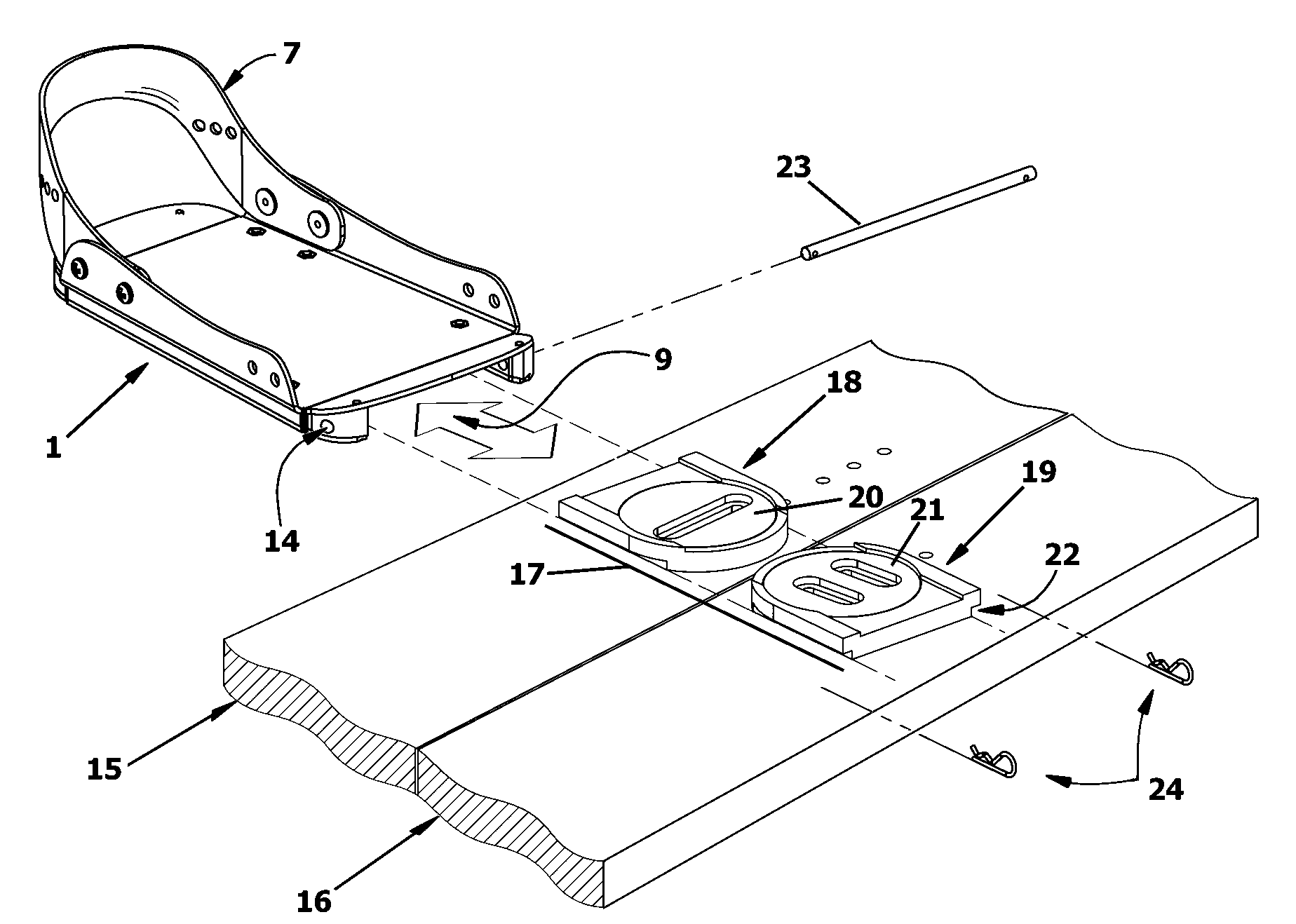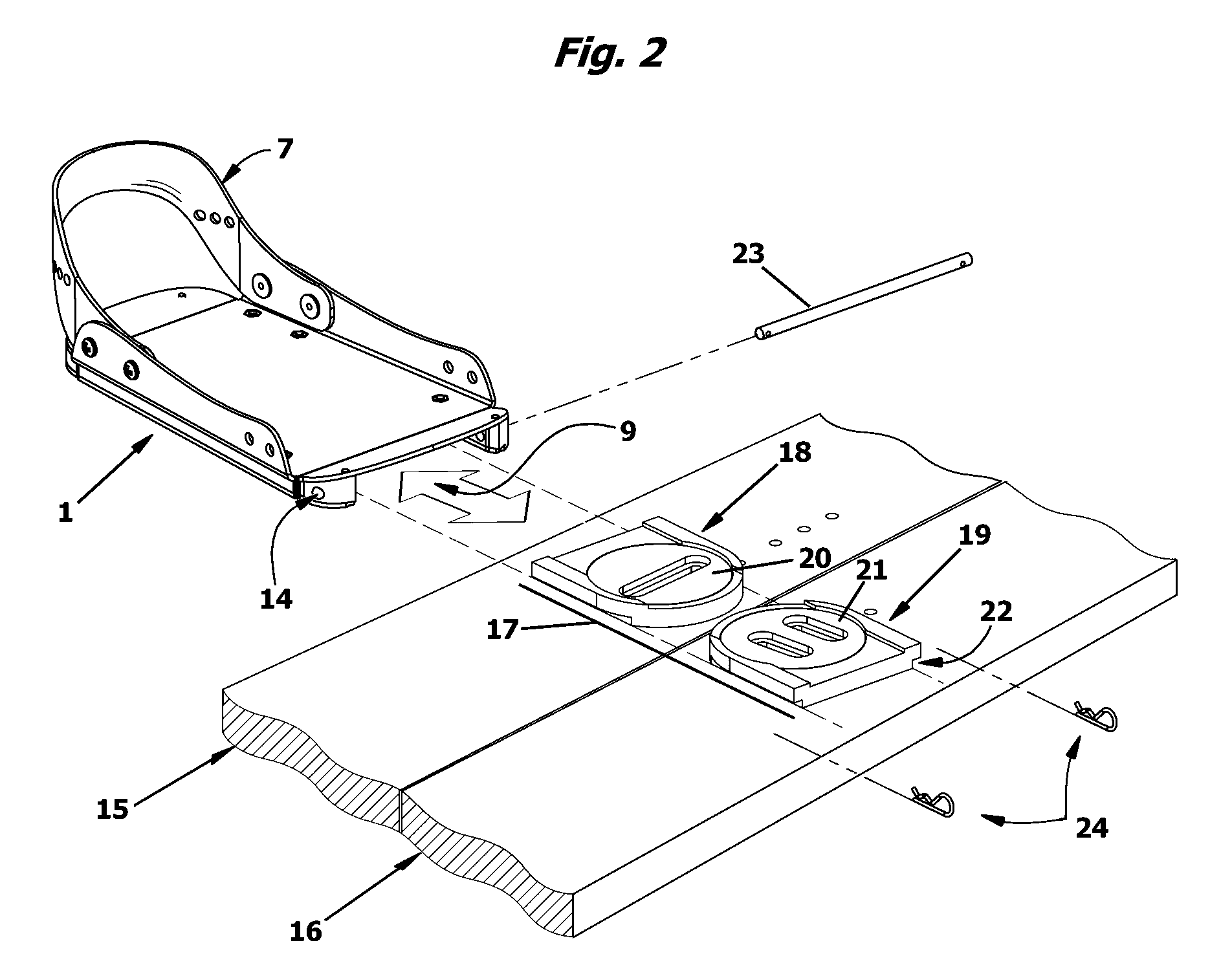Splitboard bindings
a technology of splitboards and bindings, applied in the field of splitboard bindings, can solve the problems of increasing weight, instability, decreasing the torsional stiffness (or spring constant) of the boot bindings, and lack of prior art solutions, so as to improve the ride of the splitboard, improve the performance of ski touring configuration, and facilitate the repositioning of the boots
- Summary
- Abstract
- Description
- Claims
- Application Information
AI Technical Summary
Benefits of technology
Problems solved by technology
Method used
Image
Examples
example 1
[0172]A Drake F-60 snowboard binding with integral heel cup and highback was modified in a shop by removing the upper binding baseplate (32) and 4-hole disk and substituting in their place a sheet of 2.5 mm aluminum with side rails folded up to form a shallow channel for the boot.
[0173]A three dimensional CAD design was sent to a local sheet metal house that used a CNC (computer numerically controlled) laser cutter to cut the outline and holes for the aluminum parts necessary for the bindings. Sheetmetal press brakes were then used to bend the channels of the bindings. Similarly, a CNC milling machine cut out the UHMW polyethylene spacers from a sheet of 16 mm thick plastic. This machine provided all holes, the outline, and contoured surfaces.
[0174]Using mounting bolts, the heel and toe straps and highback were secured in place. A total of 10 screws, countersunk, were placed at the circumference of the base along each side of the sandwich to secure the plastic spacer materials (webs...
example 2
[0177]Mechanical comparisons were made using a splitboard and boot binding assembly of the prior art versus that of Example 1. A Voile “Splitdecision 166” splitboard was used for the comparisons, and for the prior art testing, Drake F-60 snowboard bindings were mounted as recommended by the manufacturer on the Voile mounting hardware. The boot bindings were assembled in snowboard riding configuration for these comparisons.
[0178]Physical measurements of the two boot bindings were also made and are recorded in Table I.
TABLE IPrior ArtExample 1Distance from plane of board to26mm14mmbottom of bootWidth in contact with board under80mm120mmlateral loadWeight per boot binding1182g1015g
[0179]To measure deformation under lateral strain, which is related to spring constant K of the boot bindings, the snowboard was clamped to a vertical surface so that the highback of the boot bindings were mounted parallel to the floor. An 11.3 kg weight was then clipped onto the top of the highback, and the ...
example 3
[0183]A torsional stiffness coefficient was measured for the boot binding of FIG. 33 and compared to an equivalent measurement for a binding of the prior art (FIG. 4B). However, in order to eliminate the contribution of the upper baseplate 32, four hole disk 31 and gasket 39, these were eliminated from the test setup. To make the measurement, a lever arm consisting of a block of aluminum 7.7 inches long by 2.5 inches by 2.5 inches wide was bolted to the slider track 40 of the prior art setup or to the top plate member 3 of the inventive article of FIG. 33. A block and tackle was used to apply a force on the lever arm, which generated a torque on the binding. An angle gauge was mounted on the aluminum block to measure theta. Both boot bindings were mounted on identical mounting blocks (17-FIG. 2) which had been affixed to a splitboard for the test. The splitboard was clamped to a solid support. Deformation (as torsional rotation) versus torque was then measured. The data is plotted i...
PUM
 Login to View More
Login to View More Abstract
Description
Claims
Application Information
 Login to View More
Login to View More - R&D
- Intellectual Property
- Life Sciences
- Materials
- Tech Scout
- Unparalleled Data Quality
- Higher Quality Content
- 60% Fewer Hallucinations
Browse by: Latest US Patents, China's latest patents, Technical Efficacy Thesaurus, Application Domain, Technology Topic, Popular Technical Reports.
© 2025 PatSnap. All rights reserved.Legal|Privacy policy|Modern Slavery Act Transparency Statement|Sitemap|About US| Contact US: help@patsnap.com



